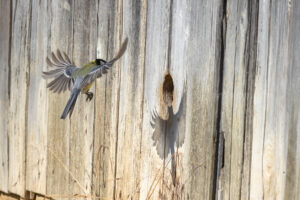 With spread wings, the Great Tit (Parus major) swoops towards a hole in a wooden wall. The Tit inspects the large round hole for a good 3 seconds during the approach, flying sometimes less than 10 cm from the entrance.
With spread wings, the Great Tit (Parus major) swoops towards a hole in a wooden wall. The Tit inspects the large round hole for a good 3 seconds during the approach, flying sometimes less than 10 cm from the entrance.
The pair of Great Tits has been doing gymnastics around an open shelter or shed already for a while. There are not only nesting boxes for Tits but also nesting boxes installed as part of a wildlife conservation and research program attached to the sides. A total of 3 nesting boxes are hanging at a distance of just 50 cm from each other on different sides of the shed.
The Great Tits will now – it is the beginning of June – probably already have their second brood. The special interest is of course the “normal” nesting box. But the other nesting boxes also seem interesting.
At some point a Great Tit detaches itself from the roof edge of the shed and first flies curiously at the dark hole in the shed at a reasonable distance. Eventually she comes flying closer and closer, so that I almost think that the flight is now taking place or at least clinging to the edge. But something is stopping the Great Tit from continuing its adventure.
The Great Tit probably would have gotten away with a shock. In fact, the hole was the entrance to a nesting box reserved for a Eurasian Hoopoe (Upupa epops) for its brood. There are 3 young Hoopoes in the nest box. The smell the young ones give off breathtaking. First I thought of food and droppings spoiled by the sun. Then the phrase “You stink like a hoopoe” came to mind. This statement is common in southern Germany and Switzerland. It comes from the fact that young birds drive away predators with a strong-smelling secretion. If they are attacked by a predator, the young are not defenseless. When attacked, they hiss angrily or squirt feces. In addition they give off a stinking secretion as a matter of habit and especially when there is danger. This odor is very unpleasant for both human and animal noses.
That would have driven the Great Tit back out of the hole as quickly as possible. You don’t have to go through every experience to the end!
To meet the growing demand for top-of-the-line images of the rarer Palaearctic species, Bird-lens.com strives to expand the range of images of Western Palaearctic birds. Trips to remote locations to take pictures of rare western Palearctic birds have been very successful. This beautiful picture of the blog was been made in a familiar site but is just a first impression of what you can find in the gallery in the “Picture Shop” very soon. Please leave a message if bird-lens.com can provide a picture.